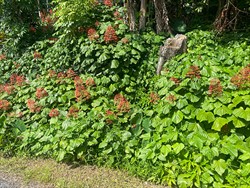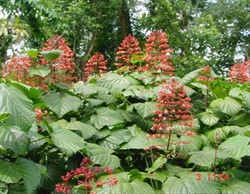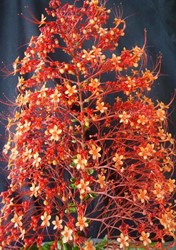Pagoda flower. It is also known as orange tower, and orange pagoda.
Pacific Pests, Pathogens, Weeds & Pesticides - Online edition
Pacific Pests, Pathogens, Weeds & Pesticides
Pagoda flower (551
Clerodendrum paniculatum. It is a member of the Lamiaceae.
Asia, Africa (Seychelles), North (Florida), South (Colombia) and Central America, the Caribbean, Oceania. It is recorded from Australia, American Samoa, Federated States of Micronesia, Fiji, French Polynesia, Guam, Marshall Islands, Nauru, Palau, Papua New Guinea, Samoa, Solomon Islands. It is native to Southeast Asia.
An invasive shrub of the tropics and subtropics, often planted as a garden ornamental for its showy flowers, which frequently escapes cultivation forming thickets in disturbed areas, forest margins, open forests, and along roadsides (Photos 1&2). Invasiveness of the weed is assisted by the prolific production of root suckers allowing rapid colonistion in new areas.
Pagoda flower prefers moist but well-drained soils in sunny places. It is found from the lowlands to 500 masl.
An erect perennial shrub, 1-2 m tall; stems 4-angled (quadrangular) with short soft hairs. Leaves, opposite along the stems, heart-shaped with pointed tips, up to 30 cm across, on yellow-brown leaf stalks up to 10 cm long. Flower cluster pyramid-shaped at the end of the stems or from axils of leaves, up to 45 cm tall, above the leaves, with long flower stalks (Photo 3). Each flower on stalks up to 15 cm, with reddish leaf-like structure (calyx) at base, red to orange tube (the corolla), 1-1.5 cm long, with five paler lobes. Male stamens and the female style are four to five times the length of the corolla tube (Photo 4). Fruits rarely seen.
Spread is vegetative by root suckers. Long distance spread is associated with the domestic and international trade of this weed for ornamental use.
A weed causing environmental impacts following escape from cultivation. A third of the island of Pingelap Atoll in the Federated States of Micronesia is covered with pagoda flower.
Pagoda flowers is popular as an ornamental in tropical gardens for its large showy flowers. It is also used to make an infusion, drunk as a purgative, and the leaves are used as a poultice for burns, wounds and ulcers. The roots have varied uses, for the lungs and for rheumatism amongst others.
BIOSECURITY
The risk of further introductions of pagoda flower is high. It is frequently used as an ornamental in gardens and all parts of the plant are used medicinally. Those countries not yet infested should consider all likely pathways for entry and apply quarantine measures accordingly. Seeds and plants of Clerodendrum paniculatum are available for sale on the Internet.
BIOLOGICAL CONTROL
Not a method recommended for Clerodendrum paniculatum.
CULTURAL CONTROL
Physical & Mechanical:
- Hand-pulling isolated plants or small infestations is possible, but labour intensive. It will need to be done repeatedly over an extended period.
CHEMICAL CONTROL
In Pohnpei, Federated States of Micronesia, triclopyr and glyphosate are used:
- Foliar spray: On young plants, use diluted following manufacturers' instructions. Make sure all stem pieces are collected to prevent regrowth. Read the label.
- Cut stump/paint: On mature plants, cut stems just above ground and brush or spray them immediately.
--------------------
Note, EU approval to use glyphosate ended in December 2022, but has been extended by one year to 15 December 2023.
____________________
When using a pesticide, always wear protective clothing and follow the instructions on the product label, such as dosage, timing of application, and pre-harvest interval. Recommendations will vary with the crop and system of cultivation. Expert advice on the most appropriate herbicides to use should always be sought from local agricultural authorities.
AUTHOR Konrad Englberger & Grahame Jackson
Information from CABI (2020) Clerodendrum paniculatum (pagoda flower). Crop Protection Compendium. (https://www.cabidigitallibrary.org/doi/10.1079/cabicompendium.119784); and Clerodendrum paniculatum L., Lamiaceae (2013) Pacific Island Ecosystems at Risk (PIER). (http://hear.org/pier/species/clerodendrum_paniculatum.htm); and Fern K (2022) Clerodendrum paniculatum L., Lamiaceae.Tropical Plants Database. (https://tropical.theferns.info/viewtropical.php?id=Clerodendrum+paniculatum); and from Clerodendrum paniculatum L.Royal Botanic Gardens Kew. Plants of the World Online. (https://powo.science.kew.org/taxon/urn:lsid:ipni.org:names:862301-1).
Produced with support from the Australian Centre for International Agricultural Research under project HORT/2016/185: Responding to emerging pest and disease threats to horticulture in the Pacific islands, implemented by the University of Queensland and the Secretariat of the Pacific.







